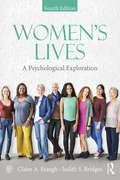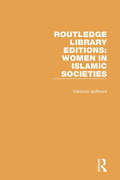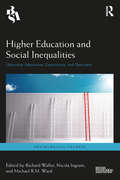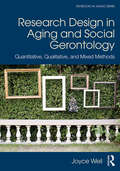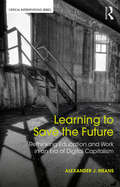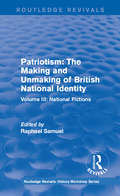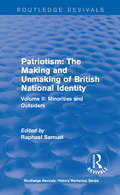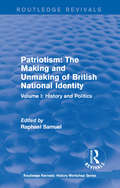- Table View
- List View
Routledge Revivals: Miners, Quarrymen and Saltworkers (Routledge Revivals: History Workshop Series)
by Raphael SamuelIndustrial discipline in mining, quarrying, brickmaking and other classes of mineral work was very different to that in nineteenth-century factories and mills. First published in 1977, this book deals with mineral workers of every class and discusses the peculiarities and common features of their work. It offers three detailed local studies: pit life in County Durham, slate quarrying in North Wales, and saltworkers in Cheshire alongside an introductory section on mineral workers in general. The author is concerned with the family and community setting; the social relationships at the point of production itself; job control and trade unionism; and with material culture, wages and earnings.
Routledge Revivals: Miners, Quarrymen and Saltworkers (Routledge Revivals: History Workshop Series)
by Raphael SamuelIndustrial discipline in mining, quarrying, brickmaking and other classes of mineral work was very different to that in nineteenth-century factories and mills. First published in 1977, this book deals with mineral workers of every class and discusses the peculiarities and common features of their work. It offers three detailed local studies: pit life in County Durham, slate quarrying in North Wales, and saltworkers in Cheshire alongside an introductory section on mineral workers in general. The author is concerned with the family and community setting; the social relationships at the point of production itself; job control and trade unionism; and with material culture, wages and earnings.
Routledge Revivals: Village Life and Labour (Routledge Revivals: History Workshop Series)
by Raphael SamuelFirst published in 1975, this volume aims to direct attention at a number of aspects of the lives and occupations of village labourers in the nineteenth-century that have been little examined by historians outside of agriculture. Some of the factors examined include the labourer’s gender, whether they lived in ‘closed’ or ‘open’ villages and what they worked at during the different seasons of the year. The author examines a range of occupations that have previously been ignored as too local to show up in national statistics or too short-lived to rank as occupations at all as well as sources of ‘secondary’ income. The analysis of all of these factors in related to the seasonal cycle of field labour and harvests. The central focus is on the cottage economy and the manifold contrivances by which labouring families attempted to keep themselves afloat.
Routledge Revivals: Village Life and Labour (Routledge Revivals: History Workshop Series)
by Raphael SamuelFirst published in 1975, this volume aims to direct attention at a number of aspects of the lives and occupations of village labourers in the nineteenth-century that have been little examined by historians outside of agriculture. Some of the factors examined include the labourer’s gender, whether they lived in ‘closed’ or ‘open’ villages and what they worked at during the different seasons of the year. The author examines a range of occupations that have previously been ignored as too local to show up in national statistics or too short-lived to rank as occupations at all as well as sources of ‘secondary’ income. The analysis of all of these factors in related to the seasonal cycle of field labour and harvests. The central focus is on the cottage economy and the manifold contrivances by which labouring families attempted to keep themselves afloat.
The Routledge Handbook of Archaeology and Globalization
by Tamar HodosThis unique collection applies globalization concepts to the discipline of archaeology, using a wide range of global case studies from a group of international specialists. The volume spans from as early as 10,000 cal. BP to the modern era, analysing the relationship between material culture, complex connectivities between communities and groups, and cultural change. Each contributor considers globalization ideas explicitly to explore the socio-cultural connectivities of the past. In considering social practices shared between different historic groups, and also the expression of their respective identities, the papers in this volume illustrate the potential of globalization thinking to bridge the local and global in material culture analysis. The Routledge Handbook of Archaeology and Globalization is the first such volume to take a world archaeology approach, on a multi-period basis, in order to bring together the scope of evidence for the significance of material culture in the processes of globalization. This work thus also provides a means to understand how material culture can be used to assess the impact of global engagement in our contemporary world. As such, it will appeal to archaeologists and historians as well as social science researchers interested in the origins of globalization.
The Routledge Handbook of Archaeology and Globalization
by Tamar HodosThis unique collection applies globalization concepts to the discipline of archaeology, using a wide range of global case studies from a group of international specialists. The volume spans from as early as 10,000 cal. BP to the modern era, analysing the relationship between material culture, complex connectivities between communities and groups, and cultural change. Each contributor considers globalization ideas explicitly to explore the socio-cultural connectivities of the past. In considering social practices shared between different historic groups, and also the expression of their respective identities, the papers in this volume illustrate the potential of globalization thinking to bridge the local and global in material culture analysis. The Routledge Handbook of Archaeology and Globalization is the first such volume to take a world archaeology approach, on a multi-period basis, in order to bring together the scope of evidence for the significance of material culture in the processes of globalization. This work thus also provides a means to understand how material culture can be used to assess the impact of global engagement in our contemporary world. As such, it will appeal to archaeologists and historians as well as social science researchers interested in the origins of globalization.
Women's Lives: A Psychological Exploration, Fourth Edition (Mysearchlab Series 15% Off Ser.)
by Claire A. Etaugh Judith S. BridgesThis cutting-edge and comprehensive fourth edition of Women’s Lives: A Psychological Perspective integrates the most current research and social issues to explore the psychological diversity of girls and women varying in age, ethnicity, social class, nationality, sexual orientation, and ableness. Written in an engaging and accessible manner, its use of vignettes, quotes, and numerous pedagogical tools effectively fosters students’ engagement, active learning, critical thinking, and social activism. New information covered includes: neoliberal feminism, standpoint theory, mujerista psychology (Chapter 1) LGBT individuals and individuals with disabilities in media (Chapter 2) testosterone testing of female athletes, precarious manhood (Chapter 3) raising a gender non-conforming child, impact of social media on body image (Chapter 4) gender differences in narcissism and Big Five personality traits, women video-game designers (Chapter 5) asexuality, transgender individuals, sexual agency, "Viagra for women" controversy (Chapter 6) adoption of frozen embryos controversy (Chapter 7) intensive mothering, integrated motherhood, "living apart together", same-sex marriage (Chapter 8) single-sex schooling controversy (Chapter 9) combat roles opened to U.S. women, managerial derailment (Chapter 10) work-hours dilemmas of low-wage workers (Chapter 11) feminist health care model, health care for transgender individuals, Affordable Care Act (Chapter 12) feminist critique of CDC guidelines on women and drinking (Chapter 13) cyberharassment, gendertrolling, campus sexual assault (Chapter 14) transnational feminism, men and feminism (Chapter 15) Women’s Lives stands apart from other texts on the psychology of women because it embeds within each topical chapter a lifespan approach and robust coverage of the impact of social, cultural, and economic factors in shaping women’s lives around the world. It provides extensive information on women with disabilities, middle-aged and older women, and women in transnational contexts. Its up-to-date coverage reflects current scientific and social developments, including over 2,200 new references. This edition also adds several new boxed features for student engagement. In The News boxes present current, often controversial, news items to get students thinking critically about real-life applications of course topics. Get Involved boxes encourage students to actively participate in the research process. What You Can Do boxes give students applied activities to promote a more egalitarian society. Learn About the Research boxes expose students to a variety of research methods and highlight the importance of diversity in research samples by including studies of underrepresented groups.
Women's Lives: A Psychological Exploration, Fourth Edition
by Claire A. Etaugh Judith S. BridgesThis cutting-edge and comprehensive fourth edition of Women’s Lives: A Psychological Perspective integrates the most current research and social issues to explore the psychological diversity of girls and women varying in age, ethnicity, social class, nationality, sexual orientation, and ableness. Written in an engaging and accessible manner, its use of vignettes, quotes, and numerous pedagogical tools effectively fosters students’ engagement, active learning, critical thinking, and social activism. New information covered includes: neoliberal feminism, standpoint theory, mujerista psychology (Chapter 1) LGBT individuals and individuals with disabilities in media (Chapter 2) testosterone testing of female athletes, precarious manhood (Chapter 3) raising a gender non-conforming child, impact of social media on body image (Chapter 4) gender differences in narcissism and Big Five personality traits, women video-game designers (Chapter 5) asexuality, transgender individuals, sexual agency, "Viagra for women" controversy (Chapter 6) adoption of frozen embryos controversy (Chapter 7) intensive mothering, integrated motherhood, "living apart together", same-sex marriage (Chapter 8) single-sex schooling controversy (Chapter 9) combat roles opened to U.S. women, managerial derailment (Chapter 10) work-hours dilemmas of low-wage workers (Chapter 11) feminist health care model, health care for transgender individuals, Affordable Care Act (Chapter 12) feminist critique of CDC guidelines on women and drinking (Chapter 13) cyberharassment, gendertrolling, campus sexual assault (Chapter 14) transnational feminism, men and feminism (Chapter 15) Women’s Lives stands apart from other texts on the psychology of women because it embeds within each topical chapter a lifespan approach and robust coverage of the impact of social, cultural, and economic factors in shaping women’s lives around the world. It provides extensive information on women with disabilities, middle-aged and older women, and women in transnational contexts. Its up-to-date coverage reflects current scientific and social developments, including over 2,200 new references. This edition also adds several new boxed features for student engagement. In The News boxes present current, often controversial, news items to get students thinking critically about real-life applications of course topics. Get Involved boxes encourage students to actively participate in the research process. What You Can Do boxes give students applied activities to promote a more egalitarian society. Learn About the Research boxes expose students to a variety of research methods and highlight the importance of diversity in research samples by including studies of underrepresented groups.
Routledge Library Editions: Women in Islamic Societies (Routledge Library Editions: Women in Islamic Societies)
by Various AuthorsWomen in Islamic societies are often seen as a hidden and homogenous group. The volumes in this set, originally published between 1960 and 1983, explore the wide variety of women’s roles in a range of Islamic societies, from Yemen, the United Arab Emirates and Kurdistan to Malaysia, West Africa, Iran and Turkey. Due to their anthropological focus, each book pays particular attention to the everyday lives of women in these regions, including their agency and power within their own communities. The titles also explore women’s changing roles in the modernising Muslim world of the 20th century. This set will be of interest to those studying women, gender, Islam and anthropology.
What’s Happened To The University?: A sociological exploration of its infantilisation
by Frank FurediThe radical transformation that universities are undergoing today is no less far-reaching than the upheavals that it experienced in the 1960s. However today, when almost 50 per cent of young people participate in higher education, what occurs in universities matters directly to the whole of society. On both sides of the Atlantic curious and disturbing events on campuses has become a matter of concern not just for academics but also for the general public. What is one to make of the growing trend of banning speakers? What’s the meaning of trigger warnings, cultural appropriation, micro-aggression or safe spaces? And why are some students going around arguing that academic freedom is no big deal? What's Happened To The University? offers an answer to the questions of why campus culture is undergoing such a dramatic transformation and why the term moral quarantine refers to the infantilising project of insulating students from offence and a variety of moral harms.
What’s Happened To The University?: A sociological exploration of its infantilisation
by Frank FurediThe radical transformation that universities are undergoing today is no less far-reaching than the upheavals that it experienced in the 1960s. However today, when almost 50 per cent of young people participate in higher education, what occurs in universities matters directly to the whole of society. On both sides of the Atlantic curious and disturbing events on campuses has become a matter of concern not just for academics but also for the general public. What is one to make of the growing trend of banning speakers? What’s the meaning of trigger warnings, cultural appropriation, micro-aggression or safe spaces? And why are some students going around arguing that academic freedom is no big deal? What's Happened To The University? offers an answer to the questions of why campus culture is undergoing such a dramatic transformation and why the term moral quarantine refers to the infantilising project of insulating students from offence and a variety of moral harms.
Higher Education and Social Inequalities: University Admissions, Experiences, and Outcomes (Sociological Futures)
by Richard Waller Nicola Ingram Michael R.M. WardA university education has long been seen as the gateway to upward social mobility for individuals from lower socio-economic backgrounds, and as a way of reproducing social advantage for the better off. With the number of young people from the very highest socio-economic groups entering university in the UK having effectively been at saturation point for several decades, the expansion witnessed in participation rates over the last few decades has largely been achieved by a modest broadening of the base of the undergraduate population in terms of both social class and ethnic diversity. However, a growing body of evidence exists in the continuation of unequal graduate outcomes. This can be seen in terms of employment trajectories in the UK. The issue of just who enjoys access to which university, and the experiences and outcomes of graduates from different institutions remain central to questions of social justice, notably higher education’s contribution to social mobility and to the reproduction of social inequality. This collection of contemporary original writings explores these issues in a range of specific contexts, and through employing a range of theoretical and methodological approaches. The relationship between higher education and social mobility has probably never been under closer scrutiny. This volume will appeal to academics, policy makers, and commentators alike. Higher Education and Social Inequalities is an important contribution to the public and academic debate.
Higher Education and Social Inequalities: University Admissions, Experiences, and Outcomes (Sociological Futures)
by Richard Waller Nicola Ingram Michael R. M. WardA university education has long been seen as the gateway to upward social mobility for individuals from lower socio-economic backgrounds, and as a way of reproducing social advantage for the better off. With the number of young people from the very highest socio-economic groups entering university in the UK having effectively been at saturation point for several decades, the expansion witnessed in participation rates over the last few decades has largely been achieved by a modest broadening of the base of the undergraduate population in terms of both social class and ethnic diversity. However, a growing body of evidence exists in the continuation of unequal graduate outcomes. This can be seen in terms of employment trajectories in the UK. The issue of just who enjoys access to which university, and the experiences and outcomes of graduates from different institutions remain central to questions of social justice, notably higher education’s contribution to social mobility and to the reproduction of social inequality. This collection of contemporary original writings explores these issues in a range of specific contexts, and through employing a range of theoretical and methodological approaches. The relationship between higher education and social mobility has probably never been under closer scrutiny. This volume will appeal to academics, policy makers, and commentators alike. Higher Education and Social Inequalities is an important contribution to the public and academic debate.
Daughters of Allah: Among Moslem Women in Kurdistan (Routledge Library Editions: Women in Islamic Societies)
by Henny Harald HansenIn 1957, Henny Harald Hansen, the first Danish female anthropologist, was invited to take part in an archaeological expedition to the site of the projected Dokan Dam on the Little Zab river in Northern Iraq. Although her responsibilities were originally ethnological, she became the guest first of the local sheik and later of her interpreter’s family and as a result, the doors of many Kurdish homes were opened to her that normally would have remained closed to foreigners. She travelled widely among the mountain villages of Iraqi Kurdistan and was able to see from very close range the everyday life of women. First published in 1958 and translated in 1960, this book contains the intimate and fascinating account of Henny Harald Hansen’s travels and her encounters with the women of Kurdistan. It will be of keen interest to those studying women in Islamic societies and anthropology.
Daughters of Allah: Among Moslem Women in Kurdistan (Routledge Library Editions: Women in Islamic Societies)
by Henny Harald HansenIn 1957, Henny Harald Hansen, the first Danish female anthropologist, was invited to take part in an archaeological expedition to the site of the projected Dokan Dam on the Little Zab river in Northern Iraq. Although her responsibilities were originally ethnological, she became the guest first of the local sheik and later of her interpreter’s family and as a result, the doors of many Kurdish homes were opened to her that normally would have remained closed to foreigners. She travelled widely among the mountain villages of Iraqi Kurdistan and was able to see from very close range the everyday life of women. First published in 1958 and translated in 1960, this book contains the intimate and fascinating account of Henny Harald Hansen’s travels and her encounters with the women of Kurdistan. It will be of keen interest to those studying women in Islamic societies and anthropology.
Research Design in Aging and Social Gerontology: Quantitative, Qualitative, and Mixed Methods (Textbooks in Aging)
by Joyce WeilResearch Design in Aging and Social Gerontology provides a review of methodological approaches and data-collection methods commonly used with older adults in real-life settings. It addresses the role of normative age-related sensory, cognitive, and functional changes, as well as the influence of generational cohort (age-period-cohort) upon each design. It discusses the role of older adults as true co-researchers; issues uniquely related to studies of persons residing in community-based, assisted, skilled, and memory-care settings; and ethical concerns related to cognitive status changes. The text concludes with detailed guidelines for improving existing data collection methods for older persons and selecting the best fitting methodologies for use in planning research on aging. Features of Research Design in Aging and Social Gerontology include: Descriptions and evaluations of a wide range of methodological approaches, and methods used to collect data about older persons (quantitative, qualitative, mixed, and emergent methods: photovoice, virtual environments, etc.) Ways to match research questions to selection of method without a preconceived methodological preference or dominance Real-world and applied examples along with cases from the gerontological literature "How to" sections about reading output/software reports and qualitative-analysis screenshots (from ATLAS.ti) and quantitative (SPSS) output and interpretation Pedagogical tools in every chapter such as text boxes, case studies, definitions of key terms, discussion questions, and references for further reading on chapter topics Glossary of key terms, complete sample research report, and an overview of past methodological research design work in gerontology Companion website at www.routledge.com/cw/Weil where instructors will find PowerPoint presentations, additional discussion questions, and a sample syllabus; and students will find flashcards based on glossary terms, a downloadable copy of the sample research report in the text, and links to data sets, related websites, further reading, and select gerontological journals This text is intended for upper-level undergraduates and masters students in aging and gerontology as well as students in human development, applied anthropology, psychology, public health, sociology, and social-work settings. Health care professionals, social workers, and care managers who work with older adults will also find this text a valuable resource.
Research Design in Aging and Social Gerontology: Quantitative, Qualitative, and Mixed Methods (Textbooks in Aging)
by Joyce WeilResearch Design in Aging and Social Gerontology provides a review of methodological approaches and data-collection methods commonly used with older adults in real-life settings. It addresses the role of normative age-related sensory, cognitive, and functional changes, as well as the influence of generational cohort (age-period-cohort) upon each design. It discusses the role of older adults as true co-researchers; issues uniquely related to studies of persons residing in community-based, assisted, skilled, and memory-care settings; and ethical concerns related to cognitive status changes. The text concludes with detailed guidelines for improving existing data collection methods for older persons and selecting the best fitting methodologies for use in planning research on aging. Features of Research Design in Aging and Social Gerontology include: Descriptions and evaluations of a wide range of methodological approaches, and methods used to collect data about older persons (quantitative, qualitative, mixed, and emergent methods: photovoice, virtual environments, etc.) Ways to match research questions to selection of method without a preconceived methodological preference or dominance Real-world and applied examples along with cases from the gerontological literature "How to" sections about reading output/software reports and qualitative-analysis screenshots (from ATLAS.ti) and quantitative (SPSS) output and interpretation Pedagogical tools in every chapter such as text boxes, case studies, definitions of key terms, discussion questions, and references for further reading on chapter topics Glossary of key terms, complete sample research report, and an overview of past methodological research design work in gerontology Companion website at www.routledge.com/cw/Weil where instructors will find PowerPoint presentations, additional discussion questions, and a sample syllabus; and students will find flashcards based on glossary terms, a downloadable copy of the sample research report in the text, and links to data sets, related websites, further reading, and select gerontological journals This text is intended for upper-level undergraduates and masters students in aging and gerontology as well as students in human development, applied anthropology, psychology, public health, sociology, and social-work settings. Health care professionals, social workers, and care managers who work with older adults will also find this text a valuable resource.
Learning to Save the Future: Rethinking Education and Work in an Era of Digital Capitalism (Critical Interventions)
by Alexander J. MeansMainstream economists and Silicon Valley entrepreneurs claim that unfettered capitalism and digital technology can unlock a future of unbounded prosperity, create endless high paying jobs, and solve the world’s vast social and ecological problems. Realizing this future of abundance purportedly rests in the transformation of human potential into innovative human capital through new 21st century forms of education. In this new book Alex Means challenges this view. Stagnating economic growth and runaway inequality have emerged as the ‘normal’ condition of advanced capitalism. Simultaneously, there has been a worldwide educational expansion and a growing surplus of college-educated workers relative to their demand in the world economy. This surplus is complicated by an emerging digital revolution driven by artificial intelligence and machine learning that generates worker displacing innovations and immaterial forms of labor and valorization. Learning to Save the Future argues that rather than fostering mass intellectuality, educational development is being constrained by a value structure subordinated to 21st century capitalism and technology. Human capabilities from creativity, design, engineering, to communication are conceived narrowly as human capital, valued in terms of economic productivity and growth. Similarly, global problems such as the erosion of employment and climate change are conceived as educational problems to be addressed through business solutions and the digitalization of education.?This thought-provoking account provides a cognitive map of this condition, offering alternatives through critical analyses of education and political economy, technology and labor, creativity and value, power and ecology.
Learning to Save the Future: Rethinking Education and Work in an Era of Digital Capitalism (Critical Interventions)
by Alexander J. MeansMainstream economists and Silicon Valley entrepreneurs claim that unfettered capitalism and digital technology can unlock a future of unbounded prosperity, create endless high paying jobs, and solve the world’s vast social and ecological problems. Realizing this future of abundance purportedly rests in the transformation of human potential into innovative human capital through new 21st century forms of education. In this new book Alex Means challenges this view. Stagnating economic growth and runaway inequality have emerged as the ‘normal’ condition of advanced capitalism. Simultaneously, there has been a worldwide educational expansion and a growing surplus of college-educated workers relative to their demand in the world economy. This surplus is complicated by an emerging digital revolution driven by artificial intelligence and machine learning that generates worker displacing innovations and immaterial forms of labor and valorization. Learning to Save the Future argues that rather than fostering mass intellectuality, educational development is being constrained by a value structure subordinated to 21st century capitalism and technology. Human capabilities from creativity, design, engineering, to communication are conceived narrowly as human capital, valued in terms of economic productivity and growth. Similarly, global problems such as the erosion of employment and climate change are conceived as educational problems to be addressed through business solutions and the digitalization of education.?This thought-provoking account provides a cognitive map of this condition, offering alternatives through critical analyses of education and political economy, technology and labor, creativity and value, power and ecology.
Routledge Revivals: Volume III: National Fictions (Routledge Revivals: History Workshop Series)
by Raphael SamuelFirst published in 1989, this is the third of three volumes exploring the changing notions of patriotism in British life from the thirteenth century to the late twentieth century and constitutes an attempt to come to terms with the power of the national idea through a historically informed critique. This volume studies some of the leading figures of national myth, such as Britannia and John Bull. One group of essays looks at the idea of distinctively national landscape and the ways in which it corresponds to notions of social order. A chapter on the poetry of Edmund Spenser explores metaphorical representations of Britain as a walled garden, and the idea of an enchanted national space is taken up in a series of essays on literature, theatre and cinema. An introductory piece charts some of the startling changes in the image of national character, from the seventeenth-century notion of the English as the most melancholy people in Europe, to the more uncertain and conflicting images of today.
Routledge Revivals: Volume III: National Fictions (Routledge Revivals: History Workshop Series)
by Raphael SamuelFirst published in 1989, this is the third of three volumes exploring the changing notions of patriotism in British life from the thirteenth century to the late twentieth century and constitutes an attempt to come to terms with the power of the national idea through a historically informed critique. This volume studies some of the leading figures of national myth, such as Britannia and John Bull. One group of essays looks at the idea of distinctively national landscape and the ways in which it corresponds to notions of social order. A chapter on the poetry of Edmund Spenser explores metaphorical representations of Britain as a walled garden, and the idea of an enchanted national space is taken up in a series of essays on literature, theatre and cinema. An introductory piece charts some of the startling changes in the image of national character, from the seventeenth-century notion of the English as the most melancholy people in Europe, to the more uncertain and conflicting images of today.
Routledge Revivals: Volume II: Minorities and Outsiders (Routledge Revivals: History Workshop Series)
by Raphael SamuelFirst published in 1989, this is the second of three volumes exploring the changing notions of patriotism in British life from the thirteenth century to the late twentieth century and constitutes an attempt to come to terms with the power of the national idea through a historically informed critique. This volume examines how national identity has competed with alternative, more personal forms of belonging — such as Roman Catholicism, Judaism and Nonconformism — as well looking at femininity in relation to the state. Contemporary British society’s capacity to create outsiders is discussed and the introductory essay shows how this may shape our misunderstanding of earlier phases of national development.
Routledge Revivals: Volume II: Minorities and Outsiders (Routledge Revivals: History Workshop Series)
by Raphael SamuelFirst published in 1989, this is the second of three volumes exploring the changing notions of patriotism in British life from the thirteenth century to the late twentieth century and constitutes an attempt to come to terms with the power of the national idea through a historically informed critique. This volume examines how national identity has competed with alternative, more personal forms of belonging — such as Roman Catholicism, Judaism and Nonconformism — as well looking at femininity in relation to the state. Contemporary British society’s capacity to create outsiders is discussed and the introductory essay shows how this may shape our misunderstanding of earlier phases of national development.
Routledge Revivals: Volume I: History and Politics (Routledge Revivals: History Workshop Series)
by Raphael SamuelFirst published in 1989, this is the first of three volumes exploring the changing notions of patriotism in British life from the thirteenth century to the late twentieth century and constitutes an attempt to come to terms with the power of the national idea through a historically informed critique. This volume deals with the role of politics, history, religion, imperialism and race in the formation of English nationalism. In chapters dealing with a wide range of topics, the contributors demystify the prevailing conceptions of nationalism, suggesting ‘the nation’ has always been a contested idea, and only one of a number of competing images of collectivity.
Routledge Revivals: Volume I: History and Politics (Routledge Revivals: History Workshop Series)
by Raphael SamuelFirst published in 1989, this is the first of three volumes exploring the changing notions of patriotism in British life from the thirteenth century to the late twentieth century and constitutes an attempt to come to terms with the power of the national idea through a historically informed critique. This volume deals with the role of politics, history, religion, imperialism and race in the formation of English nationalism. In chapters dealing with a wide range of topics, the contributors demystify the prevailing conceptions of nationalism, suggesting ‘the nation’ has always been a contested idea, and only one of a number of competing images of collectivity.



